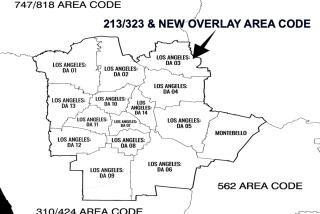Siding With Consumers on 818
- Share via
The state Public Utilities Commission signaled that it’s getting with the program when it voted Thursday to adopt number conservation measures to keep the 818 area code intact.
No one knows how number conservation is going to work--or if it’s going to work. That’s because it hasn’t been tried. When phone companies said they’d run out of numbers, communities across the country just rolled over and accepted new area codes--often at great inconvenience and expense to businesses and consumers--rather than questioning the way numbers are distributed in the first place.
That is, until the prospect of new area codes reached the San Fernando Valley and West Los Angeles. To the surprise of telephone companies, Angelenos put up a fight.
In anticipation of an overlay in the 310 area code, meaning that new phones would be assigned a different area code, Westsiders began having to dial 11 numbers--1 plus the area code plus the number--instead of seven, even for local calls. The Valley was threatened with an overlay of 818. Legislators’ phones started ringing off the hook, and they passed legislation directing the PUC to come up with a better plan to meet the need for new phone numbers.
The PUC is attempting just that. With the Federal Communications Commission’s permission to implement number conservation measures, the PUC will now examine phone companies’ books to determine whether all numbers have been exhausted in 818. They will reduce the inefficient blocks of 10,000 numbers previously distributed and shrink them to 1,000 numbers. Unused numbers are to go in a pool for redistribution.
Will such measures work to prolong the life of 818? The critics are skeptical and, in truth, no one knows how effective the measures will be. But we won’t know until we try. And consumers clearly want such an effort. As commissioner Joel Z. Hyatt put it at Thursday’s vote, “[The public has] concluded, and I agree, that industry indifference, government inefficiency and regulatory complacency were not sufficient justification for change.”
The PUC signaled it is complacent no more.
More to Read
Sign up for Essential California
The most important California stories and recommendations in your inbox every morning.
You may occasionally receive promotional content from the Los Angeles Times.













